Development and Evaluation of Liquid Plaster Loaded with Chromolaena odorata Leaf Extract Endowed with Several Beneficial Properties to Wound Healing
Abstract
:1. Introduction
2. Results
2.1. Physical Appearance, Identification and Quantification of Active Substance from Chromolaena odorata Extracts
2.2. Antimicrobial Activity of Chromolaena odorata Extracts
2.3. Antioxidant Activity of Chromolaena odorata Extracts
2.4. Blood Coagulation Test of Chromolaena odorata Extract
2.5. Cytotoxicity
2.6. Formulation of Liquid Plaster
2.6.1. Rheological Properties
2.6.2. Liquid Drying Time
2.6.3. Film Mechanical Properties
2.7. Physical Properties and Antimicrobial Activity of Liquid Plaster Formulation Loaded Chromolaena odorata Extract
2.7.1. Shear Viscosity, Film Drying, and Young’s Modulus
2.7.2. Water Vapor Transmission
2.7.3. Antimicrobial Activity by Agar Well Diffusion Method
2.8. In Vivo Study of Skin Irritation, Transepidermal Water Loss and Skin Density after Liquid Plaster Use
3. Conclusions
4. Materials and Methods
4.1. Materials
4.2. Chromolaena odorata Extract
4.3. Identification and Quantification of Active Substance from Chromolaena odorata Extracts
4.4. Antimicrobial Activity of Chromolaena odorata Extracts
4.4.1. Disk Diffusion Method
4.4.2. Minimum Inhibitory Concentration (MIC)
4.4.3. Minimum Bactericidal Concentration (MBC)
4.5. Antioxidant Activity of Chromolaena odorata Extracts
4.5.1. ABTS Assay
4.5.2. DPPH Assay
4.6. Blood Coagulation Test of Chromolaena odorata Extract
4.7. Cytotoxicity
4.8. Formulation of Liquid Plaster
4.9. Evaluation of Liquid Plaster
4.9.1. Rheological Properties
4.9.2. Liquid Drying Time
4.9.3. Film Mechanical Properties
4.9.4. Water Vapor Transmission
4.9.5. Antibacterial Activity of Films Loaded Chromolaena odorata Extract
4.10. In Vivo Study of Skin Irritation, Transepidermal Water Loss and Skin Density after Liquid Plaster Use
4.11. Statistical Analysis
Supplementary Materials
Author Contributions
Funding
Institutional Review Board Statement
Informed Consent Statement
Acknowledgments
Conflicts of Interest
References
- Boateng, J.S.; Matthews, K.H.; Stevens, H.N.; Eccleston, G.M. Wound healing dressings and drug delivery systems: A review. J. Pharm. Sci. 2008, 97, 2892–2923. [Google Scholar] [CrossRef] [PubMed]
- Knottenbelt, D. Factors that delay healing. J. Eq. Vet. Sci. 2002, 22, 451–455. [Google Scholar]
- Bucknall, T. Factors affecting wound-healing. Probl. Gen. Surg. 1989, 6, 194–219. [Google Scholar]
- Tenehaus, M.; Hans-Oliver, R. Topical Agents and Dressings for Local Burn Wound Care; UpToDate: Waltham, MA, USA, 2018. [Google Scholar]
- Huanbutta, K.; Sittikijyothin, W.; Sangnim, T. Development of topical natural based film forming system loaded propolis from stingless bees for wound healing application. J. Pharm. Investig. 2020, 50, 625–634. [Google Scholar] [CrossRef]
- Daristotle, J.L.; Lau, L.W.; Erdi, M.; Hunter, J.; Djoum, A., Jr.; Srinivasan, P.; Wu, X.; Basu, M.; Ayyub, O.B.; Sandler, A.D. Sprayable and biodegradable, intrinsically adhesive wound dressing with antimicrobial properties. Bioeng. Transl. Med. 2020, 5, e10149. [Google Scholar] [CrossRef] [Green Version]
- Dhiman, S.; Singh, T.G.; Rehni, A.K. Transdermal patches: A recent approach to new drug delivery system. Int. J. Pharm. Pharm. Sci. 2011, 3, 26–34. [Google Scholar]
- Shariatinia, Z.; Barzegari, A. Polysaccharide Hydrogel Films/Membranes for Transdermal Delivery of Therapeutics. In Polysaccharide Carriers for Drug Delivery; Woodhead Publishing: Sawston, UK, 2019; pp. 639–684. [Google Scholar]
- Misra, A.; Pal, R.; Majumdar, S.S.; Talwar, G.; Singh, O. Biphasic testosterone delivery profile observed with two different transdermal formulations. Pharm. Res. 1997, 14, 1264–1268. [Google Scholar] [CrossRef]
- Gohel, M.C.; Nagori, S.A. Fabrication of modified transport fluconazole transdermal spray containing ethyl cellulose and Eudragit® RS100 as film formers. AAPS PharmSciTech. 2009, 10, 684–691. [Google Scholar] [CrossRef]
- Ammar, H.; Ghorab, M.; Mahmoud, A.; Makram, T.; Ghoneim, A. Rapid pain relief using transdermal film forming polymeric solution of ketorolac. Pharm. Dev. Technol. 2013, 18, 1005–1016. [Google Scholar] [CrossRef]
- Furuishi, T.; Kunimasu, K.; Fukushima, K.; Ogino, T.; Okamoto, K.; Yonemochi, E.; Tomono, K.; Suzuki, T. Formulation design and evaluation of a transdermal drug delivery system containing a novel eptazocine salt with the Eudragit® E adhesive. J. Drug Deliv. Sci. Technol. 2019, 54, 101289. [Google Scholar] [CrossRef]
- Femenia-Font, A.; Padula, C.; Marra, F.; Balaguer-Fernandez, C.; Merino, V.; Lopez-Castellano, A.; Nicoli, S.; Santi, P. Bioadhesive monolayer film for the in vitro transdermal delivery of sumatriptan. J. Pharm. Sci. 2006, 95, 1561–1569. [Google Scholar] [CrossRef] [PubMed]
- Ilango, K.; Maharajan, G.; Narasimhan, S. Anti-nociceptive and anti-inflammatory activities of Azadirachta indica fruit skin extract and its isolated constituent azadiradione. Nat. Prod. Res. 2013, 27, 1463–1467. [Google Scholar] [CrossRef] [PubMed]
- Janssen, A.; Chin, N.; Scheffer, J.; Svendsen, A.B. Screening for antimicrobial activity of some essential oils by the agar overlay technique. Pharm. Weekbl. 1986, 8, 289–292. [Google Scholar] [CrossRef]
- Petronilho, S.; Maraschin, M.; Coimbra, M.A.; Rocha, S.M. In vitro and in vivo studies of natural products: A challenge for their valuation. The case study of chamomile (Matricaria recutita L.). Ind. Crop. Prod. 2012, 40, 1–12. [Google Scholar] [CrossRef]
- Maver, T.; Maver, U.; Stana Kleinschek, K.; Smrke, D.M.; Kreft, S. A review of herbal medicines in wound healing. Int. J. Dermatol. 2015, 54, 740–751. [Google Scholar] [CrossRef]
- Sittikijyothin, W.; Phonyotin, B.; Sangnim, T.; Huanbutta, K. Using carboxymethyl gum from Tamarindus indica and Cassia fistula seeds with Chromolaena odorata leaf extract to develop antibacterial gauze dressing with hemostatic activity. Res. Pharm. Sci. 2021, 16, 118–128. [Google Scholar] [PubMed]
- Phan, T.T.; Allen, J.; Hughes, M.A.; Cherry, G.; Wojnarowska, F. Upregulation of adhesion complex proteins and fibronectin by human keratinocytes treated with an aqueous extract from the leaves of Chromolaena odorata (Eupolin). Eur. J. Dermatol. 2000, 10, 522–527. [Google Scholar]
- Chen, X.-Q.; Xiao, J.-B. RP-HPLC-DAD detrmination of flavonoids: Separation of quercetin, luteolin and apigenin in Marchantia convoluta. Iran. J. Pharm. Res. 2005, 4, 175–181. [Google Scholar]
- Thophon, S.H.S.; Waranusantigul, P.; Kangwanrangsan, N.; Krajangsang, S. Antimicrobial activity of Chromolaena odorata extracts against bacterial human skin infections. Mod. Appl. Sci. 2016, 10, 159–171. [Google Scholar]
- Lezoul, N.E.H.; Belkadi, M.; Habibi, F.; Guillén, F. Extraction processes with several solvents on total bioactive compounds in different organs of three medicinal plants. Molecules 2020, 25, 4672. [Google Scholar] [CrossRef]
- Omokhua-Uyi, A.G.; Abdalla, M.A.; Leonard, C.M.; Aro, A.; Uyi, O.O.; Van Staden, J.; McGaw, L.J. Flavonoids isolated from the South African weed Chromolaena odorata (Asteraceae) have pharmacological activity against uropathogens. BMC Complement. Med. Ther. 2020, 20, 233. [Google Scholar] [CrossRef] [PubMed]
- Akomas, S.; Ijioma, S. Bleeding and clotting time effect of ethanolic extracts of Chromolaena odorata versus Ocimum gratissimum treated albino rats. J. Med Sci. 2014, 2, 9–13. [Google Scholar]
- Koba, K.; Catherine, G.; Raynaud, C.; Chaumont, J.-P.; Sanda, K.; Laurence, N. Chemical composition and cytotoxic activity of Chenopodium ambrosioides L. essential oil from Togo. Bangladesh J. Sci. Ind. Res. 2009, 44, 435–440. [Google Scholar] [CrossRef] [Green Version]
- Asomugha, R. Acute and Cytotoxicity Studies of Aqueous and Ethanolic Leaf Extracts of Chromolaena odorata. Pak. J. Biol. Sci. 2015, 18, 46–49. [Google Scholar] [CrossRef] [PubMed] [Green Version]
- Zhong, L.; Oostrom, M.; Truex, M.J.; Vermeul, V.R.; Szecsody, J.E. Rheological behavior of xanthan gum solution related to shear thinning fluid delivery for subsurface remediation. J. Hazard. Mater. 2013, 244, 160–170. [Google Scholar] [CrossRef]
- ISO. Plastics—Polymers/Resins in the Liquid State or as Emulsions or Dispersions—Determination of Viscosity Using a Rotational Viscometer with Defined Shear Rate; ISO 3219:1993; International Organization for Standardization: Geneva, Switzerland, 1993. [Google Scholar]
- Li, Y.; He, H.; Ma, Y.; Geng, Y.; Tan, J. Rheological and mechanical properties of ultrahigh molecular weight polyethylene/high density polyethylene/polyethylene glycol blends. Adv. Ind. Eng. Polym. Res. 2019, 2, 51–60. [Google Scholar] [CrossRef]
- Elejalde, C.C.; Kokini, J.L. The psychophysics of pouring, spreading and in-mouth viscosity. J. Texture Stud. 1992, 23, 315–336. [Google Scholar] [CrossRef]
- Budavari, S.; O’Neil, M.J.; Smith, A.; Heckelman, P.E. The Merck Index, 11th ed.; Merck Rahway: Kenilworth, NJ, USA, 1989. [Google Scholar]
- Raoult, F. General law of the vapor pressure of solvents. Comptes Rendus 1887, 104, 1430–1433. [Google Scholar]
- Reichardt, C.; Welton, T. Solvents and Solvent Effects in Organic Chemistry; John Wiley & Sons: Hoboken, NJ, USA, 2010. [Google Scholar]
- Yuan, J.; Shang, P.P.; Wu, S.H. Effects of polyethylene glycol: On morphology, thermomechanical properties, and water vapor permeability of cellulose acetate-free films. Pharm. Technol. 2001, 25, 62–74. [Google Scholar]
- Gould, P.L.; Goodman, M.; Hanson, P.A. Investigation of the solubility relationships of polar, semi-polar and non-polar drugs in mixed co-solvent systems. Int. J. Pharm. 1984, 19, 149–159. [Google Scholar] [CrossRef]
- Wu, P.; Fisher, A.C.; Foo, P.P.; Queen, D.; Gaylor, J.D. In vitro assessment of water vapour transmission of synthetic wound dressings. Biomaterials 1995, 16, 171–175. [Google Scholar] [CrossRef]
- Saringat, H.B.; Alfadol, K.I.; Khan, G.M. The influence of different plasticizers on some physical and mechanical properties of hydroxypropyl methylcellulose free films. Pak. J. Pharm. Sci. 2005, 18, 25–38. [Google Scholar] [PubMed]
- Rosa, J.M.; Bonato, L.B.; Mancuso, C.B.; Martinelli, L.; Okura, M.H.; Malpass, G.R.P.; Granato, A.C. Antimicrobial wound dressing films containing essential oils and oleoresins of pepper encapsulated in sodium alginate films. Ciênc. Rural 2018, 48, e20170740. [Google Scholar] [CrossRef]
- Hurkmans, J.; Bodde, H.; Van Driel, L.; Van Doorne, H.; Junginger, H. Skin irritation caused by transdermal drug delivery systems during long-term (5 days) application. Br. J. Dermatol. 1985, 112, 461–467. [Google Scholar] [CrossRef] [PubMed]
- Olsen, L.O.; Takiwaki, H.; Serup, J. High-frequency ultrasound characterization of normal skin. Skin thickness and echographic density of 22 anatomical sites. Ski. Res. Technol. 1995, 1, 74–80. [Google Scholar] [CrossRef] [PubMed]
- Lachenmeier, D.W. Safety evaluation of topical applications of ethanol on the skin and inside the oral cavity. J. Occup. Med. Toxicol. 2008, 3, 26. [Google Scholar] [CrossRef] [PubMed] [Green Version]
- Rao, K.S.; Chaudhury, P.K.; Pradhan, A. Evaluation of anti-oxidant activities and total phenolic content of Chromolaena odorata. Food Chem. Toxicol. 2010, 48, 729–732. [Google Scholar]
- Chessa, D.; Ganau, G.; Spiga, L.; Bulla, A.; Mazzarello, V.; Campus, G.V.; Rubino, S. Staphylococcus aureus and Staphylococcus epidermidis virulence strains as causative agents of persistent infections in breast implants. PLoS ONE 2016, 11, e0146668. [Google Scholar] [CrossRef] [PubMed]
- Wiegand, I.; Hilpert, K.; Hancock, R.E. Agar and broth dilution methods to determine the minimal inhibitory concentration (MIC) of antimicrobial substances. Nat. Protoc. 2008, 3, 163–175. [Google Scholar] [CrossRef]
- Alderman, D.; Smith, P. Development of draft protocols of standard reference methods for antimicrobial agent susceptibility testing of bacteria associated with fish diseases. Aquaculture 2001, 196, 211–243. [Google Scholar] [CrossRef]
- Gao, H.; Shupe, T.F.; Eberhardt, T.L.; Hse, C.Y. Antioxidant activity of extracts from the wood and bark of Port Orford cedar. J. Wood Sci. 2007, 53, 147–152. [Google Scholar] [CrossRef]
- Omokhua, A.; Ondua, M.; Van Staden, J.; McGaw, L.J. Synergistic activity of extracts of three South African alien invasive weeds combined with conventional antibiotics against selected opportunistic pathogens. S. Afr. J. Bot. 2019, 124, 251–257. [Google Scholar] [CrossRef]
- Pandith, H.; Thongpraditchote, S.; Wongkrajang, Y.; Gritsanapan, W. In vivo and in vitro hemostatic activity of Chromolaena odorata leaf extract. Pharm. Biol. 2012, 50, 1073–1077. [Google Scholar] [CrossRef]
- Xu, R.; Xia, H.; He, W.; Li, Z.; Zhao, J.; Liu, B.; Wang, Y.; Lei, Q.; Kong, Y.; Bai, Y. Controlled water vapor transmission rate promotes wound-healing via wound re-epithelialization and contraction enhancement. Sci. Rep. 2016, 6, 24596. [Google Scholar] [CrossRef] [PubMed] [Green Version]
- WMA. World Medical Association Declaration of Helsinki: Ethical Principles for Medical Research Involving Human Subjects. JAMA 2003, 310, 2191–2194. [Google Scholar]
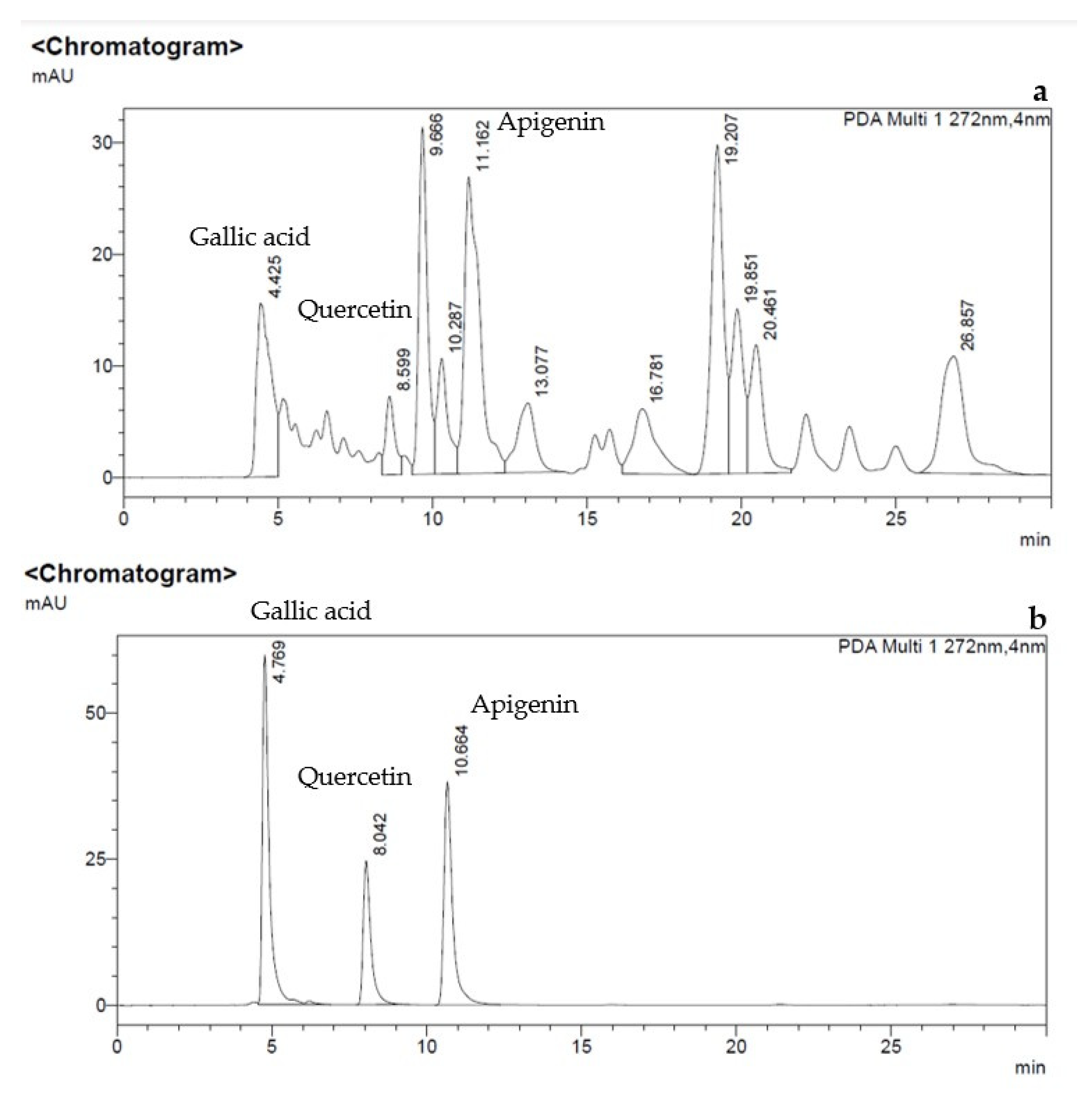
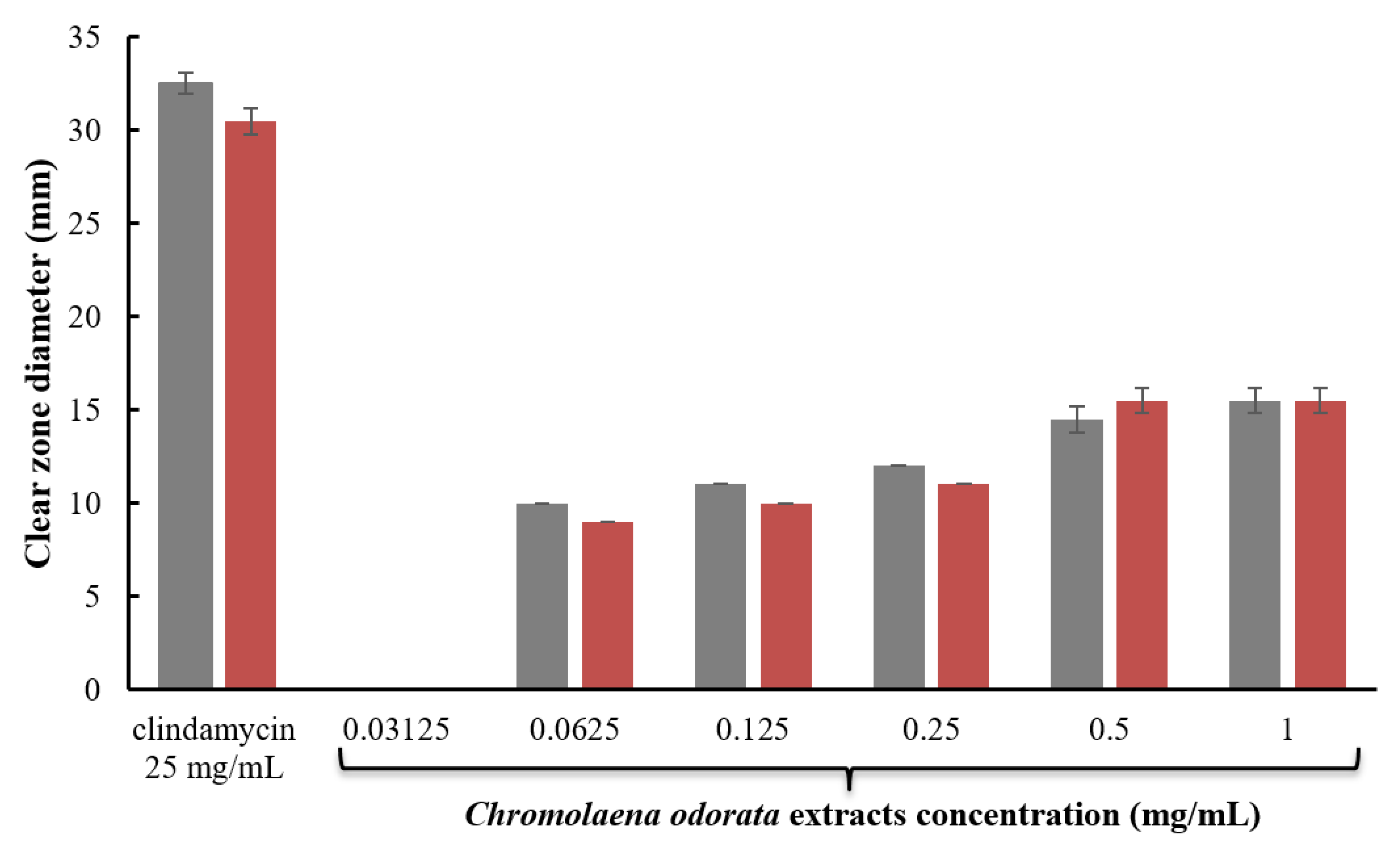

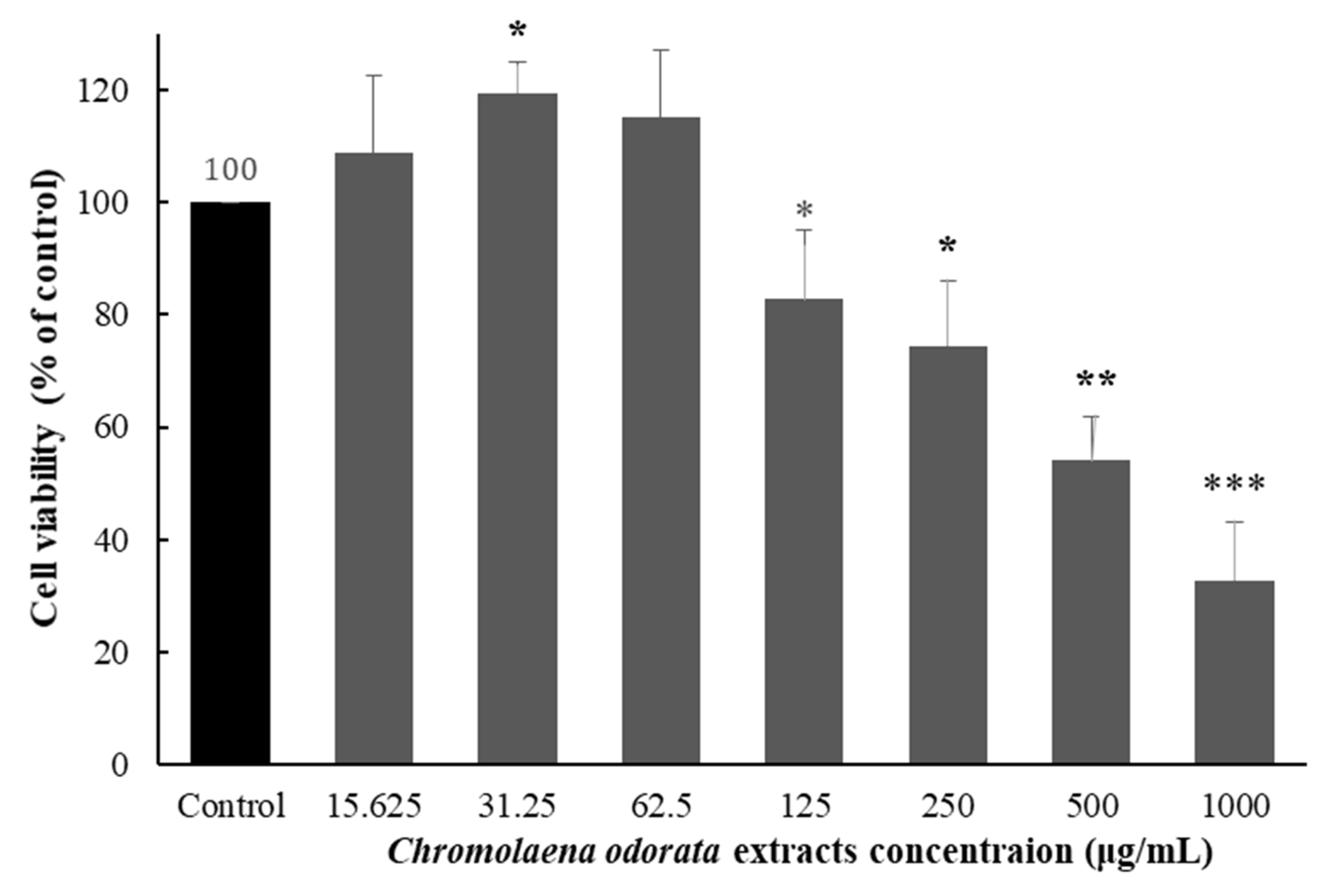
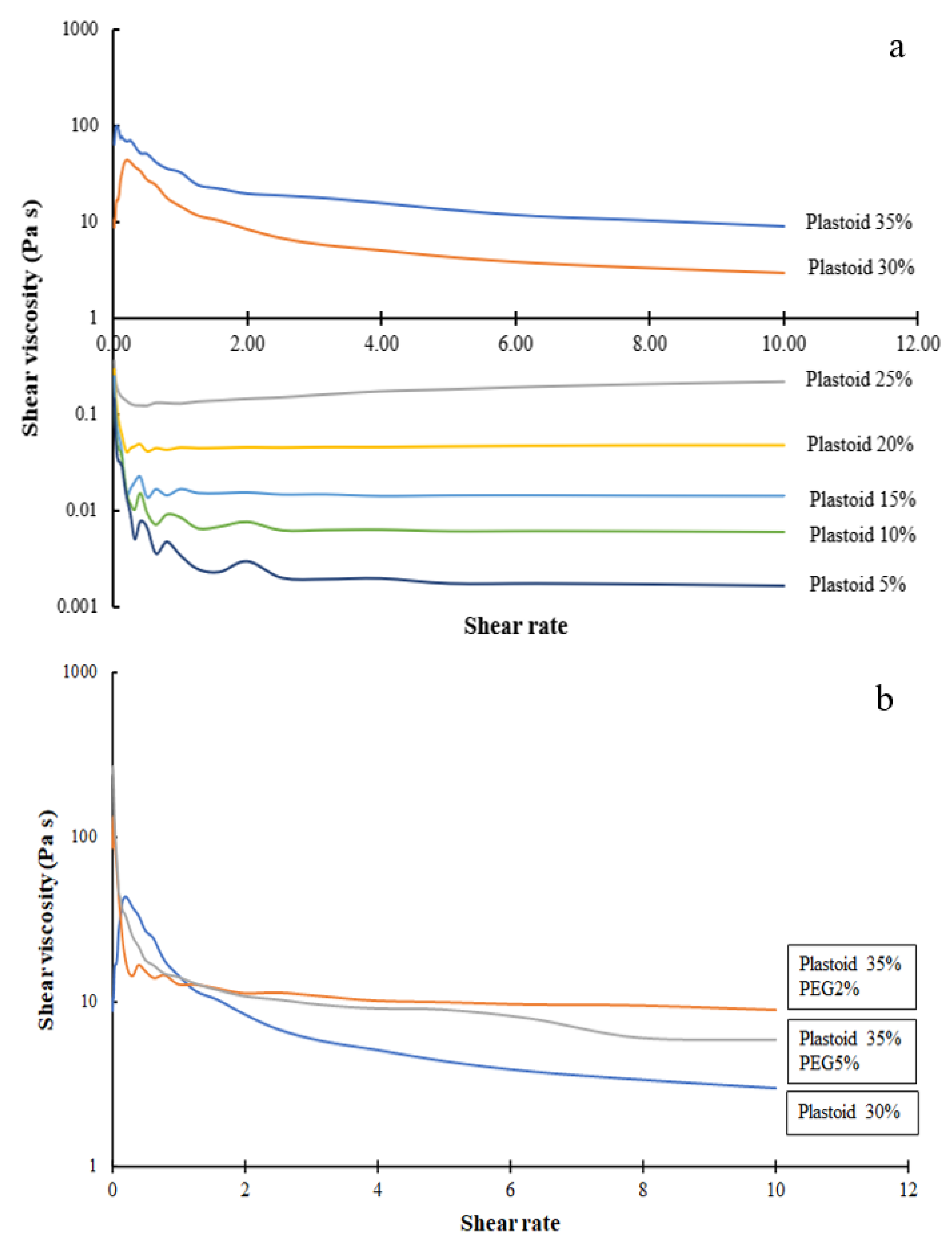
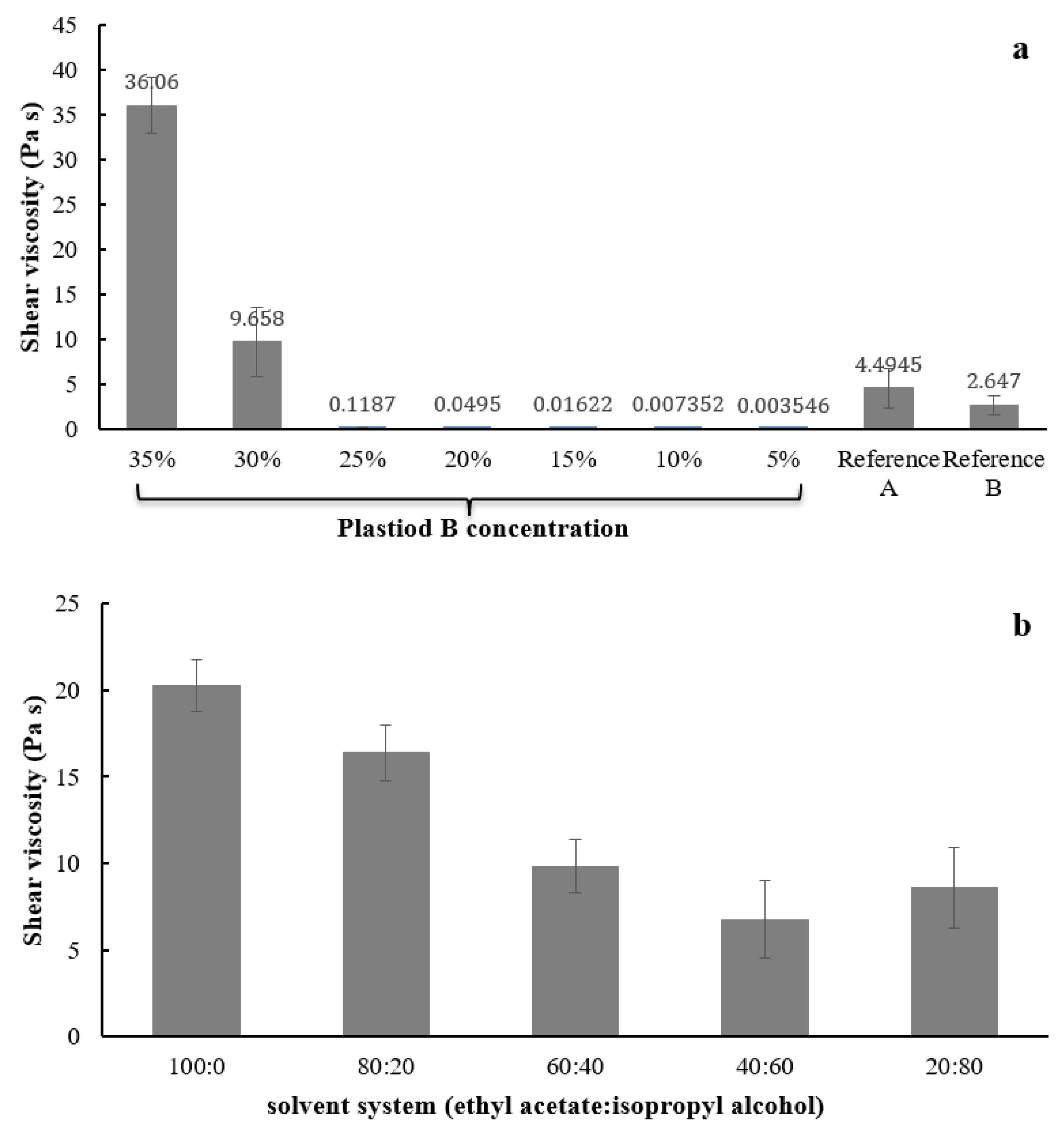

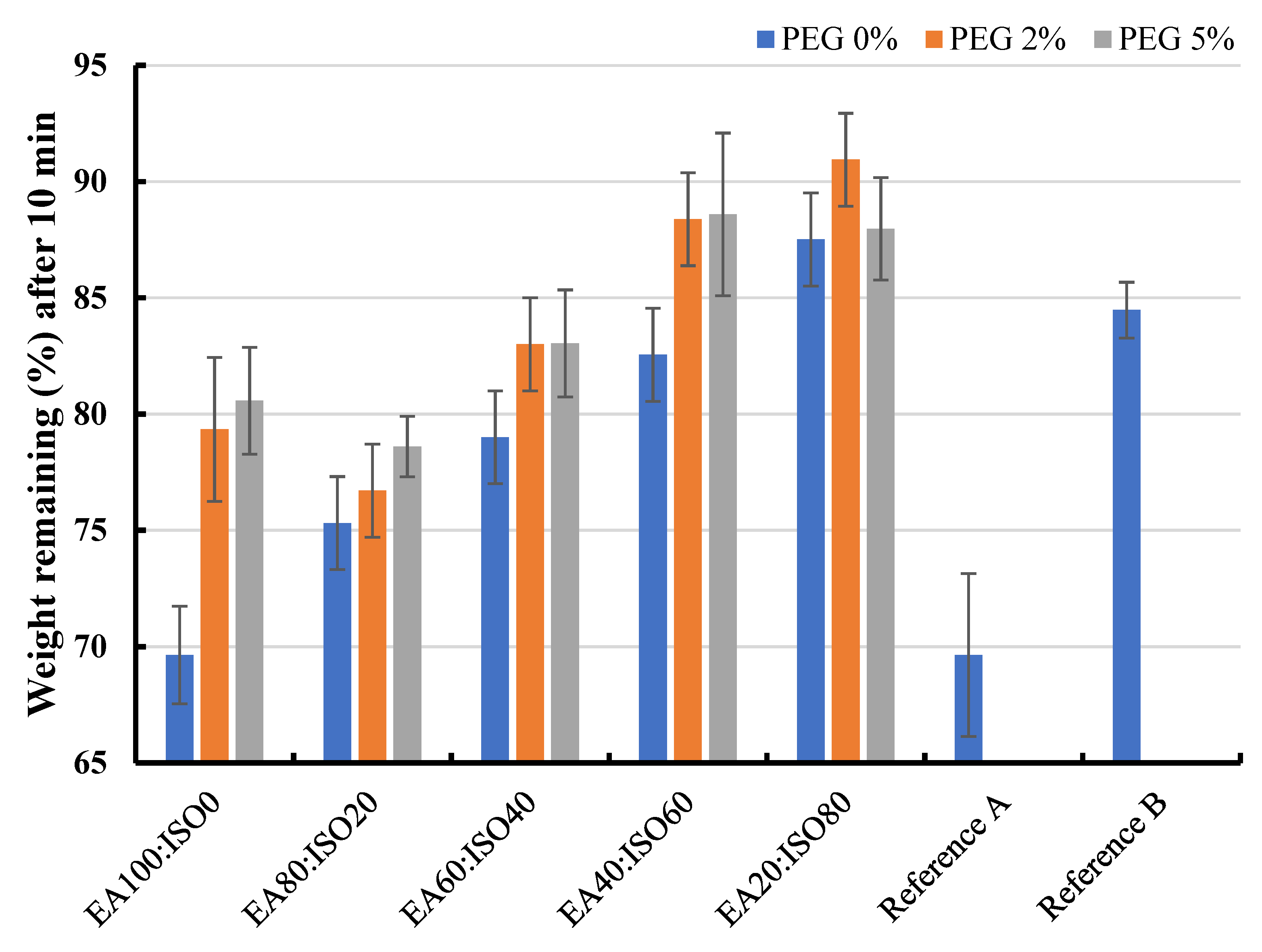

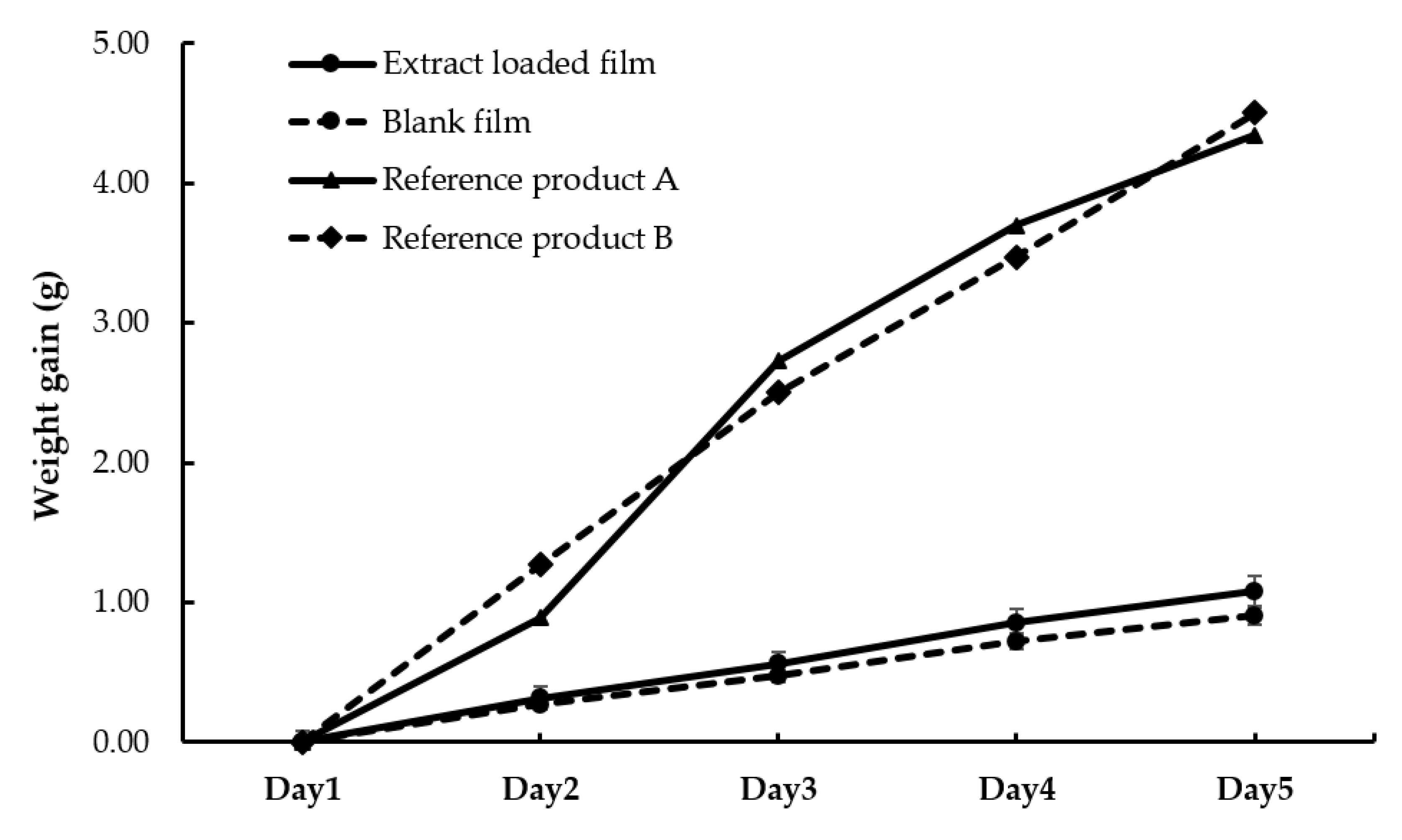
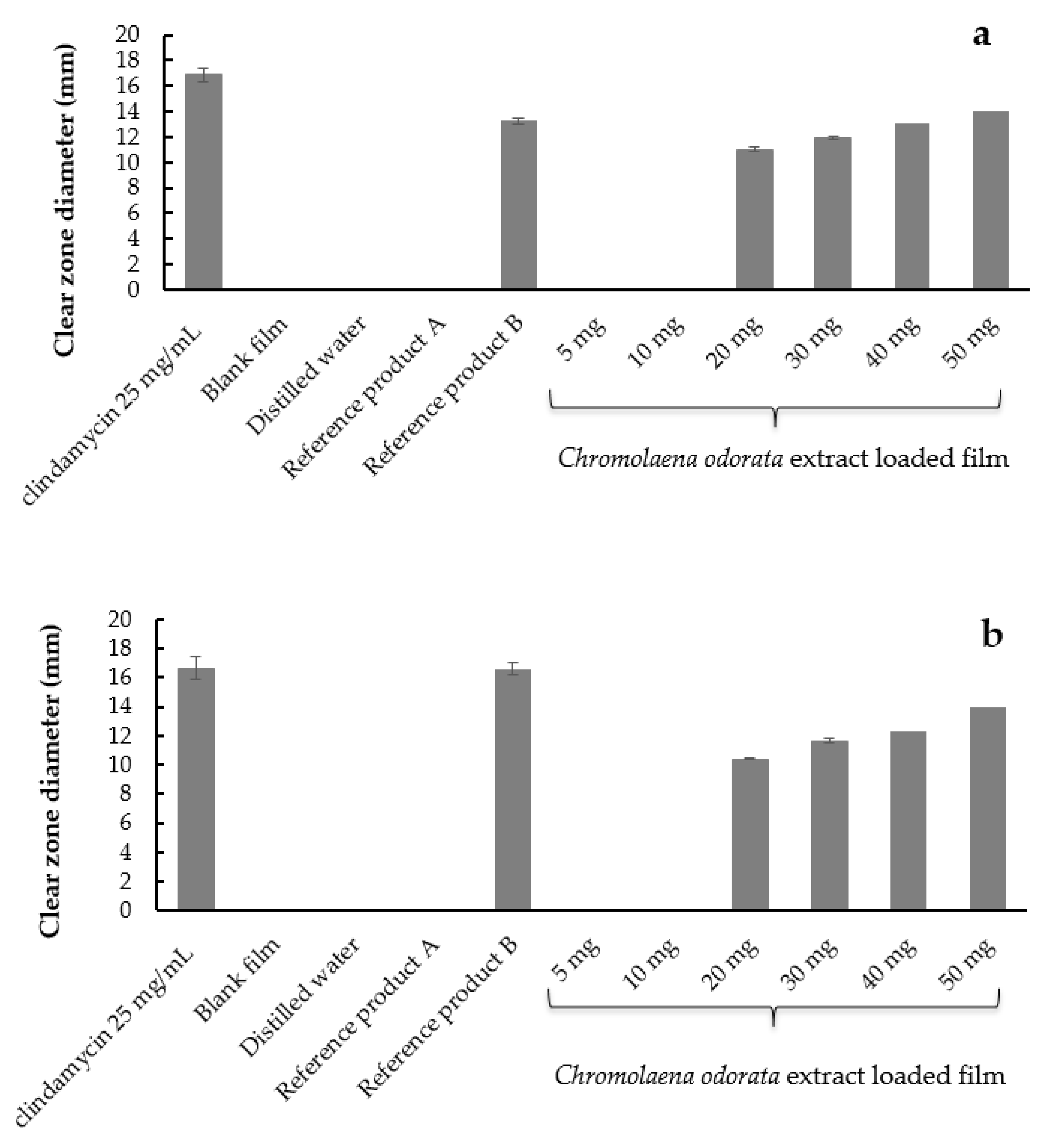
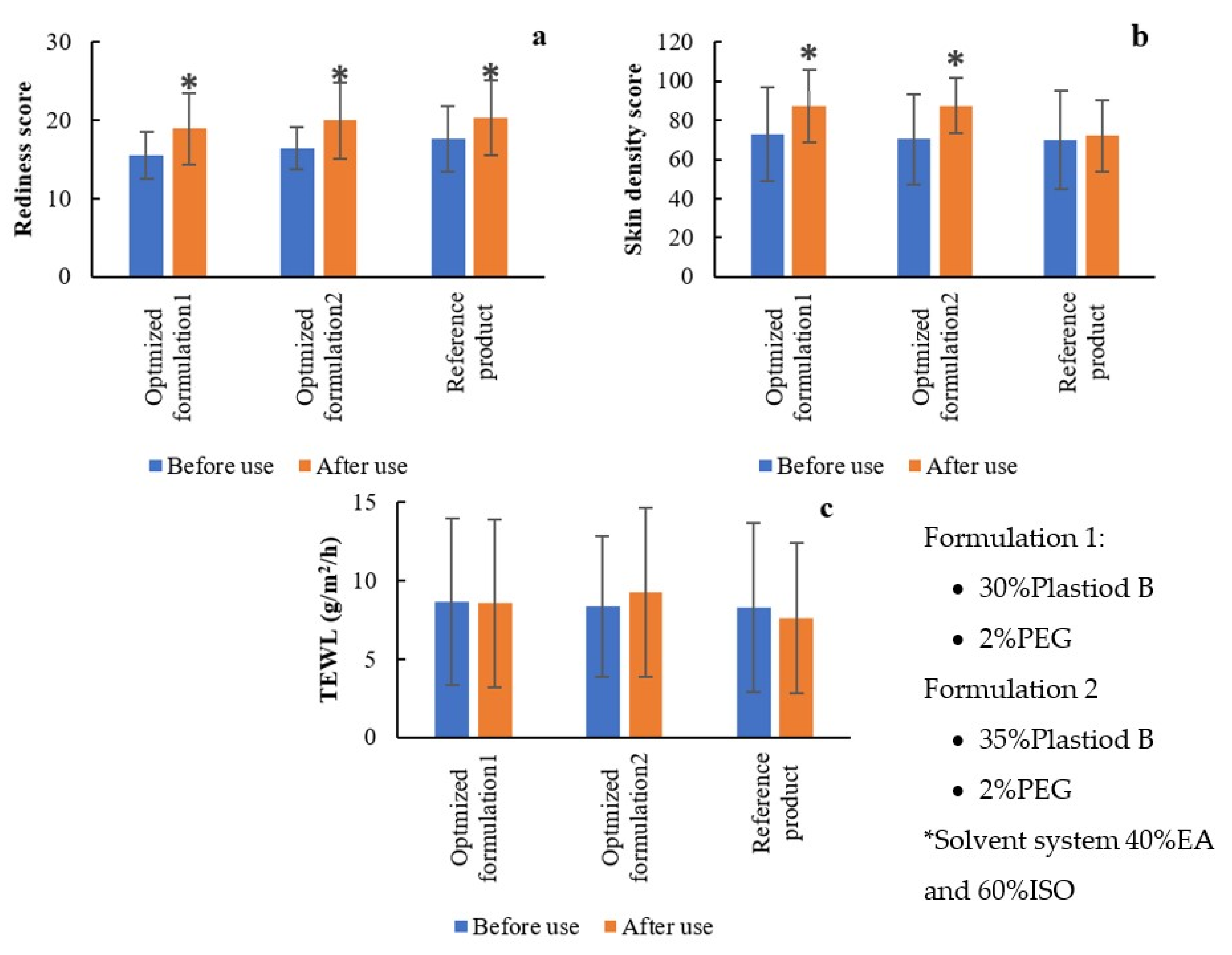
| Compound | Amount of the Compound (mg) | Percent Yield of the Compound from Extract (%) |
|---|---|---|
| Gallic acid | 6.59 ± 0.03 | 0.077 ± 0.000 |
| Quercetin | 5.02 ± 0.11 | 0.059 ± 0.001 |
| Apigenin | 17.92 ± 3.53 | 0.209 ± 0.041 |
| Pathogenic Bacteria | MIC (mg/mL) | MBC (mg/mL) |
|---|---|---|
| S. epidermidis | 0.25 mg/mL | 0.5 mg/mL |
| S. aureus | 0.25 mg/mL | 0.5 mg/mL |
| Shear Viscosity at 1 s−1 (Pa s) | W10min (%) | Young’s Modulus (MPa) | |
|---|---|---|---|
| Blank liquid plaster formulation | 9.82 | 83.09 | 0.00076 |
| Liquid plaster formulation-loaded Chromolaena odorata extract | 10.79 | 80.84 | 0.00165 |
| Reference product A | 2.65 | 84.47 | 0.00028 |
| Reference product B | 4.49 | 69.64 | 0.00046 |
| Formulation | Ingredients (%w/w) | |||
|---|---|---|---|---|
| Plastoid® B | PEG 400 | Ethyl Acetate | Isopropyl Alcohol | |
| F 1.1 | 5 | - | 95 | - |
| F 1.2 | 10 | - | 90 | - |
| F 1.3 | 15 | - | 85 | - |
| F 1.4 | 20 | - | 80 | - |
| F 1.5 | 25 | - | 75 | - |
| F 1.6 | 30 | - | 70 | - |
| F 1.7 | 35 | - | 65 | - |
| F 2.1 | 30 | - | 56 | 14 |
| F 2.2 | 30 | - | 42 | 28 |
| F 2.3 | 30 | - | 28 | 42 |
| F 2.4 | 30 | - | 14 | 56 |
| F 3.1 | 30 | 2 | 68 | - |
| F 3.2 | 30 | 2 | 55 | 13 |
| F 3.3 | 30 | 2 | 41 | 27 |
| F 3.4 | 30 | 2 | 27 | 41 |
| F 3.5 | 30 | 2 | 13 | 55 |
| F 4.1 | 30 | 5 | 65 | - |
| F 4.2 | 30 | 5 | 53.5 | 11.5 |
| F 4.3 | 30 | 5 | 39.5 | 25.5 |
| F 4.4 | 30 | 5 | 25.5 | 39.5 |
| F 4.5 | 30 | 5 | 11.5 | 53.5 |
Publisher’s Note: MDPI stays neutral with regard to jurisdictional claims in published maps and institutional affiliations. |
© 2022 by the authors. Licensee MDPI, Basel, Switzerland. This article is an open access article distributed under the terms and conditions of the Creative Commons Attribution (CC BY) license (https://creativecommons.org/licenses/by/4.0/).
Share and Cite
Sangnim, T.; Meeboon, P.; Phongsewalak, P.; Prasongdee, P.; Sriamornsak, P.; Singh, I.; Manmuan, S.; Huanbutta, K. Development and Evaluation of Liquid Plaster Loaded with Chromolaena odorata Leaf Extract Endowed with Several Beneficial Properties to Wound Healing. Gels 2022, 8, 72. https://doi.org/10.3390/gels8020072
Sangnim T, Meeboon P, Phongsewalak P, Prasongdee P, Sriamornsak P, Singh I, Manmuan S, Huanbutta K. Development and Evaluation of Liquid Plaster Loaded with Chromolaena odorata Leaf Extract Endowed with Several Beneficial Properties to Wound Healing. Gels. 2022; 8(2):72. https://doi.org/10.3390/gels8020072
Chicago/Turabian StyleSangnim, Tanikan, Parinya Meeboon, Parinda Phongsewalak, Parichat Prasongdee, Pornsak Sriamornsak, Inderbir Singh, Suwisit Manmuan, and Kampanart Huanbutta. 2022. "Development and Evaluation of Liquid Plaster Loaded with Chromolaena odorata Leaf Extract Endowed with Several Beneficial Properties to Wound Healing" Gels 8, no. 2: 72. https://doi.org/10.3390/gels8020072
APA StyleSangnim, T., Meeboon, P., Phongsewalak, P., Prasongdee, P., Sriamornsak, P., Singh, I., Manmuan, S., & Huanbutta, K. (2022). Development and Evaluation of Liquid Plaster Loaded with Chromolaena odorata Leaf Extract Endowed with Several Beneficial Properties to Wound Healing. Gels, 8(2), 72. https://doi.org/10.3390/gels8020072








